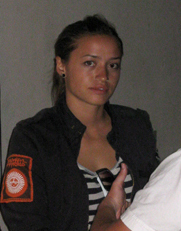
Santa Fe University of Art and Design (SFUAD) was a private for-profit art school in Santa Fe, New Mexico. The university was built from the non-profit College of Santa Fe (CSF), a Catholic facility founded as St. Michael's College in 1859, and renamed the College of Santa Fe in 1966. After financial difficulties in 2009, the college closed and the campus was purchased by the City of Santa Fe, the State of New Mexico, and Laureate Education, and reopened with a narrowed focus on film, theater, graphic design, and fine arts. As Santa Fe University of Art and Design it became a secular college of 950 students. The university closed in May 2018 due to significant ongoing financial challenges.
Patrick Bruce "Pat" Oliphant is an Australian-born American artist whose career spanned more than sixty years. His body of work as a whole focuses mostly on American and global politics, culture, and corruption; he is particularly known for his caricatures of American presidents and other powerful leaders. Over the course of his long career, Oliphant produced thousands of daily editorial cartoons, dozens of bronze sculptures, as well as a large oeuvre of drawings and paintings. He retired in 2015.

The Corcoran Gallery of Art is a former art museum in Washington, D.C., that is now the location of the Corcoran School of the Arts and Design, a part of the George Washington University. Due to a prolonged economic crisis, the Gallery closed in October 2014, with its school transferring to GWU and the 19,456 works in its collection distributed to other museums and institutions in Washington, D.C.

The Corcoran School of the Arts and Design is the professional art school of the George Washington University, in Washington, D.C. Founded in 1878, the school is housed in the Corcoran Gallery of Art, the oldest private cultural institution in Washington, located on The Ellipse, facing the White House. The Corcoran School is part of GW's Columbian College of Arts and Sciences and was formerly an independent college, until 2014.

Kenneth Price was an American artist who predominantly created ceramic sculpture. He studied at the Chouinard Art Institute and Otis Art Institute in Los Angeles, before receiving his BFA degree from the University of Southern California in 1956. He continued his studies at Chouinard Art Institute in 1957 and received an MFA degree from New York State College of Ceramics at Alfred University in 1959. Kenneth Price studied ceramics with Peter Voulkos at Otis and was awarded a Tamarind Fellowship.
Washington Project for the Arts, founded in 1975, is a non-profit organization dedicated to the support and aid of artists in the Washington, D.C. area.

Linda Lomahaftewa is a Hopi and Choctaw printmaker, painter, and educator living in Santa Fe, New Mexico.
Rob Forbes is an American designer and entrepreneur. He is the founder of the furniture company Design Within Reach, and of the bicycle retailer Public Bikes.

Carol Brown Goldberg is an American artist working in a variety of media. While primarily a painter creating heavily detailed work as large as 10 feet by 10 feet, she is also known for sculpture, film, and drawing. Her work has ranged from narrative genre paintings to multi-layered abstractions to realistic portraits to intricate gardens and jungles.
Beth Lo in Lafayette, Indiana is an American artist, ceramist and educator. Her parents emigrated from China.
Paul Greenhalgh is a British historian, writer, museologist, and curator of art and design.
Mala Breuer was an American Abstract Expressionist. Her work is in the collections of the San Francisco Museum of Modern Art, Albright Knox Art Gallery in Buffalo, and the Museum of Fine Arts, Santa Fe, New Mexico.
Oli Sihvonen was a post-World War II American artist known for hard-edge abstract paintings. Sihvonen's style was greatly influenced by Josef Albers who taught him color theory and Bauhaus aesthetics at Black Mountain College in the 1940s. Sihvonen was also influenced by Russian Constructivism, Piet Mondrian, and Pierre Matisse. His work has been linked to Abstract Expressionism, Minimalism, Hard-Edge and Op-Art.

Rick Dillingham (1952–1994) was an American ceramic artist, scholar, collector and museum professional best known for his broken pot technique and scholarly publications on Pueblo pottery.

Azalea Thorpe was a Scottish-born American weaver and textile designer. Known for her innovative experimentation with both natural and synthetic materials, Thorpe was a featured instructor and lecturer throughout the United States. She has weavings in the permanent collection of the Victoria and Albert Museum. An annual award given in her honor is presented by the Institute of American Indian Arts for fiber arts.

Rose B. Simpson is a mixed-media artist who works in ceramic, metal, fashion, painting, music, performance, and installation. She lives and works in Santa Clara Pueblo, New Mexico. Her work has been exhibited at SITE Santa Fe ; the Heard Museum ; the Museum of Contemporary Native Art, Santa Fe (2010); the National Museum of the American Indian, Smithsonian (2008); the Denver Art Museum; Pomona College Museum of Art (2016); Ford Foundation Gallery (2019); The Wheelwright Museum of the American Indian (2017); the Minneapolis Institute of Art (2019); the Savannah College of Art and Design (2020); and the Nevada Museum of Art (2021).
Christine McHorse, also known as Christine Nofchissey McHorse, was a Navajo ceramic artist from Santa Fe, New Mexico.

Rob Rogers is an editorial cartoonist. His cartoons appeared in The Pittsburgh Press from 1984 to 1993, and the Pittsburgh Post-Gazette from 1993 to 2018. In 1999 and 2019, he was a finalist for the Pulitzer Prize for Editorial Cartooning.
Daisy Quezada Ureña is an American visual artist and educator. She was born in California and is based in Santa Fe, New Mexico. Informed through her Mexican-American cultural background, Quezada addresses social issues including immigration, gender inequality, labor, and class issues. She creates ceramic and fabric works and installations that speak on themes of identity and place in relation to social structures and imposed borders.










